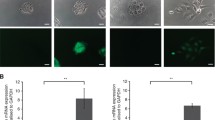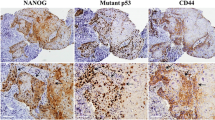Abstract
SOX4 is a member of the SOX family of transcription regulators. In recent years, SOX4 was shown to be overexpressed in cancers of various organs and related to epithelial-mesenchymal transition, which is a metastatic factor. This study was the first to investigate correlations between SOX4 expression levels and the clinicopathologic factors of oral squamous cell carcinoma (OSCC). We analyzed SOX4 expression levels in 50 patients with OSCC using immunohistochemistry. All samples expressed the SOX4 protein and elevated SOX4 expression was significantly correlated with gender, T status, and stage levels. The expression level of SOX4 in primary foci of poorly differentiated OSCC was higher than that of well differentiated OSCC, which indicated that SOX4 expression is associated with the differentiation of OSCC. However, regardless of the differentiation level in the primary focus, SOX4 expression levels were found to be very high in the metastatic focus. Furthermore, SOX4 expression in metastatic foci was significantly suppressed by neoadjuvant therapy. These results indicate that undifferentiated OSCC cells expressing SOX4 are more likely to metastasize and neoadjuvant therapy including chemoradiation therapy may have some effect in metastatic prevention.



Similar content being viewed by others
References
Massano J, Regateiro FS, Januario G, Ferreira A (2006) Oral squamous cell carcinoma:review of prognostic and predictive factors. Oral Surg Oral Med Oral Pathol Oral Radiol Endod 102:67–76
Kademani D (2007) Oral cancer. Mayo Clin Proc 82:878–887
Warnakulasuriya S (2010) Living with oral cancer: epidemiology with particular reference to prevalence and life-style changes that influence survival. Oral Oncol 46:407–410
Jemal A, Siegel R, Xu J, Ward E (2010) Cancer statistics, 2010. CA Cancer J Clin 60:277–300
Sano D, Myers JN (2007) Metastasis of squamous cell carcinoma of the oral tongue. Cancer Metastasis Rev 26:645–662
Sinclair AH, Berta P, Palmer MS, Hawkins JR, Griffiths BL, Smith MJ, Foster JW, Frischauf AM, Lovell-Badge R, Goodfellow PN (1990) A gene from the human sex-determining region encodes a protein with homology to a conserved DNA-binding motif. Nature 346:240–244
Bowles J, Schepers G, Koopman P (2000) Phylogeny of the SOX family of developmental transcription factors based on sequence and structural indicators. Dev Biol 227:239–255
Busslinger M (2004) Transcriptional control of early B cell development. Annu Rev Immunol 22:55–79
Sinner D, Kordich JJ, Spence JR, Opoka R, Rankin S, Lin SCJ, Jonatan D, Zorn AM, Wells JM (2007) Sox17 and Sox4 differentially regulate h-catenin/T-cell factor activity and proliferation of colon carcinoma cells. Mol Cell Biol 27:7802–7815
van de Wetering M, Oosterwegel M, van Norren K, Clevers H (1993) Sox-4, an Sry-like HMG box protein, is a transcriptional activator in lymphocytes. EMBO J 12:3847–3854
Graham JD, Hunt SM, Tran N, Clarke CL (1999) Regulation of the expression and activity by progestins of a member of the SOX gene family of transcriptional modulators. J Mol Endocrinol 22:295–304
Liu P, Ramachandran S, Ali Seyed M, Scharer CD, Laycock N, Dalton WB, Williams H, Karanam S, Datta MW, Jaye DL, Moreno CS (2006) Sex-determining region Y box 4 is a transforming oncogene in human prostate cancer cells. Cancer Res 66:4011–4019
Scharer CD, McCabe CD, Ali-Seyed M, Berger MF, Bulyk ML, Moreno CS (2009) Genome-wide promoter analysis of the SOX4 transcriptional network in prostate cancer cells. Cancer Res 69:709–717
Andersen CL, Christensen LL, Thorsen K, Schepeler T, Sørensen FB, Verspaget HW, Simon R, Kruhøffer M, Aaltonen LA, Laurberg S, Ørntoft TF (2009) Dysregulation of the transcription factors SOX4, CBFB and SMARCC1 correlates with outcome of colorectal cancer. Br J Cancer 100:511–523
Aaboe M, Birkenkamp-Demtroder K, Wiuf C, Sørensen FB, Thykjaer T, Sauter G, Jensen KME, Dyrskjøt L, Ørntoft T (2006) SOX4 expression in bladder carcinoma: clinical aspects and in vitro functional characterization. Cancer Res 66:3434–3442
Medina PP, Castillo SD, Blanco S, Sanz-Garcia M, Largo C, Alvarez S, Yokota J, Gonzalez-Neira A, Benitez J, Clevers HC, Cigudosa JC, Lazo PA, Sanchez-Cespedes M (2009) The SRY-HMG box gene, SOX4, is a target of gene amplification at chromosome 6p in lung cancer. Hum Mol Genetics 18:1343–1352
Kudo-Saito C, Shirako H, Takeuchi T, Kawakami Y (2009) Cancer metastasis is accelerated through immunosuppression during Snail-induced EMT of cancer cells. Cancer Cell 15:195–206
Zhang J, Liang Q, Lei Y, Yao M, Li L, Gao X, Feng J, Zhang Y, Gao H, Liu DX, Lu J, Huang B (2012) SOX4 induces epithelial-mesenchymal transition and contributes to breast cancer progression. Cancer Res 72:4597–4608
Eastham AM, Spencer H, Ritson S, Soncin F, Merry CL, Stern PL, Ward CM (2007) Epithelial-mesenchymal transition events during human embryonic stem cell differentiation. Cancer Res 67:11254–11262
Guarino M (2007) Epithelial-mesenchymal transition and tumour invasion. Int J Biochem Cell Biol 39:2153–2160
Pramoonjago P, Baras AS, Moskaluk CA (2006) Knockdown of Sox4 expression by RNAi induces apoptosis in ACC3 cells. Oncogene 25:5626–5639
Pan X, Zhao J, Zhang WN, Li HY, Mu R, Zhou T, Zhang HY, Gong WL, Yu M, Man JH, Zhang PJ, Li AL, Zhang XM (2009) Induction of SOX4 by DNA damage is critical for p53 stabilization and function. Proc Natl Acad Sci USA 106:3788–3793
Tavazoie SF, Alarcon C, Oskarsson T, Padua D, Wang Q, Bos PD, Gerald WL, Massague J (2008) Endogenous human microRNAs that suppress breast cancer metastasis. Nature 451:147–152
de Bont JM, Kros JM, Passier MM, Reddingius RE, SillevisSmitt PAE, Luider TM, den Boer ML, Pieters R (2008) Differential expression and prognostic significance of SOX genes in pediatric medulloblastoma and ependymoma identified by microarray analysis. Neuro-Oncol 10:648–660
Hur W, Rhim H, Jung CK, Kim JD, Bae SH, Jang JW, Yang JM, Oh ST, Kim DG, Wang HJ, Lee SB, Yoon SK (2010) SOX4 overexpression regulates the p53-mediated apoptosis in hepatocellular carcinoma: clinical implication and functional analysis in vitro. Carcinogenesis 31:1298–1307
Fang CL, Hseu YC, Lin YF, Hung ST, Tai C, Uen YH, Lin KY (2012) Clinical and prognostic association of transcription factor SOX4 in gastric cancer. PLoS ONE 7:e52804
Sobin LH, Wittekind CH (1997) International Union Against Cancer. TNM classification of malignant tumors. 5th edn. Wiley–Liss Publications, New York
Huang YW, Liu JC, Deatherage DE, Luo J, Mutch DG, Paul J, Goodfellow PJ, Miller DS, Huang THM (2009) Epigenetic repression of microRNA-129-2 leads to overexpression of SOX4 oncogene in endometrial cancer. Cancer Res 69:9038–9046
Wang C, Zhao H, Lu J, Yin J, Zang L, Song N, Dong R, Wu T, Du X (2012) Clinicopathological significance of SOX4 expression in primary gallbladder carcinoma. Diagn Pathol 7:41
Jafarnejad SM, Wani AA, Mertinka M, Li G (2010) Prognostic significance of Sox4 expression in human cutaneous melanoma and its role in cell migration and invasion. Am J Pathol 177:32741–32752
Hoser M, Baader SL, Bosl MR, Ihmer A, Wegner M, Sock E (2007) Prolonged glial expression of Sox4 in the CNS leads to architectural cerebellar defects and ataxia. J Neurosci 27:5495–5505
Ikushima H, Todo T, Ino Y, Takahashi M, Miyazawa K, Miyazono K (2009) Autocrine TGF-b Signaling Maintains Tumorigenicity of Glioma-Initiating Cells through Sry-Related HMG-Box Factors. Cell Stem Cell 5:504–514
Humtsoe JO, Kramer RH (2010) Differential epidermal growth factor receptor signaling regulates anchorage-independent growth by modulation of the PI3 K/AKT pathway. Oncogene 29:1214–1226
Ma L, Teruya-Feldstein J, Weinberg RA (2007) Tumor invasion and metastasis initiated by microRNA-10b in breast cancer. Nature 449:682–688
Huang Q, Gumireddy K, Schrier M, le Sage C, Nagel R, Nair S, Egan DA, Li A, Huang G, Klein-Szanto AJ, Gimotty PA, Katsaros D, Coukos G, Zhang L, Puré E, Agami R (2008) The microRNAs miR-373 and miR-520c promote tumor invasion and metastasis. Nat Cell Biol 10:202–210
Author information
Authors and Affiliations
Corresponding author
Rights and permissions
About this article
Cite this article
Watanabe, M., Ohnishi, Y., Wato, M. et al. SOX4 expression is closely associated with differentiation and lymph node metastasis in oral squamous cell carcinoma. Med Mol Morphol 47, 150–155 (2014). https://doi.org/10.1007/s00795-013-0057-5
Received:
Accepted:
Published:
Issue Date:
DOI: https://doi.org/10.1007/s00795-013-0057-5




